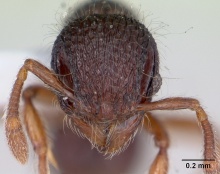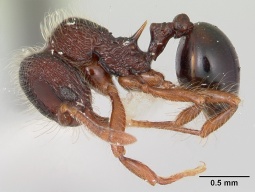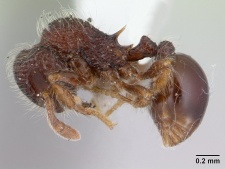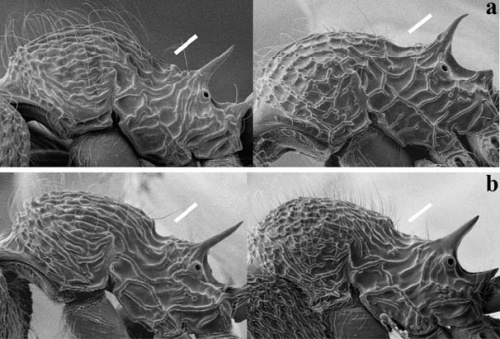Key to Lachnomyrmex species
This worker key is based on: Feitosa, R.M. & Brandão, C.R.F. 2008. A taxonomic revision of the Neotropical myrmicine ant genus Lachnomyrmex Wheeler (Hymenoptera: Formicidae). Zootaxa 1890, 1-49.
They state: "Our studies show that three main characters help to diagnose and separate the 16 Lachnomyrmex species here recognized: the presence in some species of long flexuous hairs on the first gastral segment, the overall sculpture pattern, and the comparative depth of the metanotal suture in relation to the mesosoma dorsal profile."
You may also be interested in
1
- First tergite of gaster with long (similar in length to antennal scape), flexuous hairs at least on anterior third, near the insertion of postpetiole; usually over entire surface (Fig. a) . . . . . 2
- First tergite of gaster entirely devoid of long hairs (Fig. b) . . . . . 9
2
return to couplet #1
- Metanotal groove obsolete, so that the dorsal outline of promesonotum continues to the propodeum in a slight declivity (Fig. a) . . . . . 3
- Metanotal groove impressed, so that the dorsal outline of promesonotum continues to the propodeum in an abrupt declivity (Fig. b) . . . . . 4
3
return to couplet #2
- Teeth of propodeal lobes wide dorsoventrally, in lateral view; petiolar node subtriangular; dorsum of post-petiole considerably convex and rugose; first tergite of gaster completely covered by long, flexuous hairs (continental Central America) . . . . . Lachnomyrmex scrobiculatus
 Head of Lachnomyrmex scrobiculatus worker |
 Profile of Lachnomyrmex scrobiculatus worker |
- Teeth of propodeal lobes narrow dorsoventrally, in lateral view; petiolar node dorsally flat; dorsum of postpetiole weakly convex and predominantly smooth; first tergite of gaster with about five long, sparse, flexuous hairs (Guyana) . . . . . Lachnomyrmex platynodus
 Head of Lachnomyrmex platynodus worker |
 Profile of Lachnomyrmex platynodus worker |
4
return to couplet #2
- Larger species; mesosoma length (WL) ≥ 1.20mm (Costa Rica and Colombia) . . . . . Lachnomyrmex grandis
 Lachnomyrmex grandis worker |
- Smaller species; mesosoma length (WL) < 1.20mm . . . . . 5
5
return to couplet #4
- Propodeal spines very well developed, at least twice longer than the distance between their basis; petiole extremely elongate, at least three times longer than broad in dorsal view (Colombia) . . . . . Lachnomyrmex longinodus
 Head of Lachnomyrmex longinodus worker |
 Profile of Lachnomyrmex longinodus worker |
- Propodeal spines less than twice longer than the distance between their basis; petiole shorter, less than three times long than broad in dorsal view . . . . . 6
6
return to couplet #5
- Mesosoma covered by thick and somewhat continuous rugae, transverse on anterior portion of pronotum, grading to longitudinal on rest of promesonotum and propodeum; in lateral view, promesonotum moderately convex, only slightly above the level of propodeum (Fig. a) . . . . . 7
- Mesosoma covered by finer and shorter rugae; in lateral view, promesonotum strongly convex, well above the level of propodeum (Fig. b) . . . . . 8
7
return to couplet #6
- Petiolar node relatively low, weakly raised dorsally; first tergite of gaster rather opaque and completely covered by long, flexuous hairs (Colombia) . . . . . Lachnomyrmex fernandezi
 Head of Lachnomyrmex fernandezi worker |
 Profile of Lachnomyrmex fernandezi worker |
- Petiolar node relatively high, subtriangular; first tergite of gaster strongly shining and with long, flexuous hairs only on the anterior third, near the insertion of postpetiole (Panama) . . . . . Lachnomyrmex mackayi
 Head of Lachnomyrmex mackayi worker |
 Profile of Lachnomyrmex mackayi worker |
8
return to couplet #6
- Vertexal margin of head virtually flat and relatively broad (LC ≥ 0.73mm); mesosoma length (WL) ≥ 0.90mm; metanotal groove relatively shallow and broadly impressed, without a distinct posterior limit, so that dorsal face of propodeum forms a separate plane relative to convex promesonotum (Costa Rica) . . . . . Lachnomyrmex laticeps
 Head of Lachnomyrmex laticeps worker |
 Profile of Lachnomyrmex laticeps worker |
- Vertexal margin of head convex and shorter (LC < 0.73mm); mesosoma length (WL) < 0.90mm; metanotal groove narrow and deeply impressed (Trinidad and central-northern South America) . . . . . Lachnomyrmex pilosus
 Head of Lachnomyrmex pilosus worker |
 Profile of Lachnomyrmex pilosus worker |
9
return to couplet #1
- Head and mesosoma covered by continuous rugae, transverse on anterior portion of pronotum, grading to longitudinal on rest of promesonotum and propodeum (Fig. a); dorsum of postpetiole mostly smooth and with a raised boss medially; subpostpetiolar process usually well developed . . . . . 10
- Head and mesosoma covered by irregular short rugae (Fig. b); dorsum of postpetiole mostly sculptured and without a raised boss medially; subpostpetiolar process absent or weakly developed . . . . . 11
10
return to couplet #9
- Cephalic dorsum with dense, subparallel rugae; compound eyes relatively large (EL > 0.15mm), with about 10 facets at maximum diameter; mesosoma length (WL) ≥ 0.85mm; dorsum of postpetiole entirely smooth and shining; gaster much darker than the rest of body (Costa Rica) . . . . . Lachnomyrmex regularis
 Head of Lachnomyrmex regularis worker |
 Profile of Lachnomyrmex regularis worker |
- Cephalic dorsum with rather sparser, vermiculate rugae; compound eyes smaller (EL ≤ 0.15mm), with about 7 facets at maximum diameter; mesosoma length (WL) < 0.85mm; dorsum of postpetiole with short and weak rugulation; gaster slightly darker than the rest of body (Costa Rica and Panama) . . . . . Lachnomyrmex haskinsi
 Lachnomyrmex haskinsi worker |
11
return to couplet #9
- Metanotal groove deeply impressed, so that the dorsal outline of promesonotum reaches the propodeum in an abrupt angle in profile; propodeal spines relatively thin (Venezuela) . . . . . Lachnomyrmex lattkei
 Head of Lachnomyrmex lattkei worker |
 Profile of Lachnomyrmex lattkei worker |
- Metanotal groove shallowly impressed or obsolete, so that the dorsal outline of promesonotum reaches the propodeum in a slight declivity in profile; propodeal spines with wider bases . . . . . 12
12
return to couplet #11
- Mesosoma sparsely rugose; in lateral view, promesonotum relatively low, only slightly above the level of propodeum; apex of propodeal spines curved downwards (northern Argentina and southeastern Brazil) . . . . . Lachnomyrmex plaumanni
 Head of Lachnomyrmex plaumanni worker |
 Profile of Lachnomyrmex plaumanni worker |
- Mesosoma more densely rugose; in lateral view, promesonotum higher, well above the level of propodeum; apex of propodeal spines straight to curved upwards . . . . . 13
13
return to couplet #12
- Teeth of propodeal lobes well developed and strongly projected over petiolar peduncle; dorsum of post-petiole strongly convex and densely rugose (Costa Rica and Panama) . . . . . Lachnomyrmex longinoi
 Head of Lachnomyrmex longinoi worker |
 Profile of Lachnomyrmex longinoi worker |
- Teeth of propodeal lobes reduced, not strongly projected over petiolar peduncle; dorsum of postpetiole weakly convex and more sparsely rugose . . . . . 14
14
return to couplet #13
- Dorsum of postpetiole with less than 10 long flexuous hairs, usually six (northeastern Brazil) . . . . . Lachnomyrmex nordestinus
 Head of Lachnomyrmex nordestinus worker |
 Profile of Lachnomyrmex nordestinus worker |
- Dorsum of postpetiole with 10 or more long flexuous hairs . . . . . 15
15
return to couplet #14
- Promesonotum strongly compact and elevated; apex of propodeal spines slightly directed upwards; dorsum of postpetiole with much more than 10 long, flexuous hairs (Amazonian Brazil) . . . . . Lachnomyrmex amazonicus
 Head of Lachnomyrmex amazonicus worker |
 Profile of Lachnomyrmex amazonicus worker |
- Promesonotum somewhat more elongate; propodeal spines straight; dorsum of postpetiole with about 10 long, flexuous hairs (southeastern Brazil to state of Bahia) . . . . . Lachnomyrmex victori
 Head of Lachnomyrmex victori worker |
 Profile of Lachnomyrmex victori worker |



